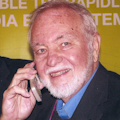There are hundreds of different types of wireless applications. We all use the familiar mainstream wireless technologies like AM and FM radio, Wi-Fi, Bluetooth, and cellular. However, there are many other unusual and less-well-known wireless types. I call them “weird wireless.” I don’t mean it in a derogatory way—just that these technologies are different and out of the ordinary. Maybe you have heard of some of these, and maybe not. Here is a short list for your distraction.
WWVB 60 kHz
WWVB is the National Institute of Standards and Technology’s (NIST) time broadcasting station in Colorado. It transmits digital time signals based on atomic clock precision (<1 part in 1012 error) to synchronize clocks across the U.S. Its carrier operating frequency is 60 kHz (yes, 60 kHz), using 70 kW of effective radiated power (ERP) from its huge antenna array. The digital time codes are sent at 1b/s (one bit per second) using a combination of amplitude and phase modulation. I have an “atomic” watch with a WWVB receiver, and the clock in my home weather station is synced to WWVB.Digital Radio Mondiale
Digital Radio Mondiale (DRM) is an effort to bring digital modulation to international short-wave broadcasting (5 to 26 MHz range), bringing it into the 21st Century. The goal is to improve upon the quality and reliability offered by the standard AM broadcast methods still used today. DRM uses MPEG audio compression to squeeze more fidelity into the traditional narrow AM 9 kHz or 10 kHz channels. Modulation is coded OFDM with QAM. Bit rates are in the 6.1 kb/s to 38.4 kb/s range. A special DRM receiver is needed.
HD Radio
HD Radio is the U.S.’s digital broadcast radio standard. It transmits a compressed audio signal using OFDM that overlays the normal analog signal on the standard AM or FM frequencies. Most FM and some AM stations have implemented it. HD Radio has been around for over a decade, but few consumers seem to know about it. It does generally improve audio quality and mitigates noise and fading. A special receiver is needed. Some car radios incorporate it.
Magnetic Induction
Magnetic induction wireless is just transformer action. And I am not talking about wireless battery charging, here. The transmitter generates a magnetic field around a primary coil or antenna. The magnetic field is picked up by multiple secondary windings or receiving antennas. Audio can be transmitted directly like this without a carrier. Such techniques have been used to send audio into a theater to special receivers for the hearing-impaired. A version called near-field magnetic induction (NFMI) uses the 13.56 MHz ISM unlicensed frequency to transmit compressed audio for ear buds and hearing aids. The near field of a radio signal is mostly the magnetic field, whereas the far field is the electric and magnetic fields together. The near-field range is severely limited to dozens of feet, max. A popular version is near-field communications (NFC) that is now widely used in cell phones for making payments.
Impulse UWB
Ultrawideband (UWB) is generally well known in its multicarrier format that uses 528 MHz wide OFDM signals in the 3.1 to 10.7 GHz range. It is used in some PCs, laptops, docking stations, and cameras to transmit data at speeds to 480 Mb/s. Range is limited a few meters, so it is not widely used.
Another version of UWB called impulse radio (IR-UWB) uses uniquely shaped short impulses and a form of PSK to transmit data. No carrier is used. The impulses create a very broad bandwidth signal (> 500 MHz). The very low power demanded by the FCC keeps the signal from interfering with other services, but a special coherent receiver can pick the signal out of the noise. Transmissions are very secure. IR-UWB is used for data transmission, ranging measurements, and location services.
PSK31
PSK31 is a digital transmission mode used by amateur radio operators. It uses a PC keyboard that translates keystrokes into a unique binary code, which then uses binary phase shift keying to modulate the carrier. PSK31 uses the sound card capability of the PC and software to handle all of the translations for both sender and receiver. The data rate is 31.25 b/s. It is very slow but only uses 100 Hz of bandwidth, making it possible to transmit data in the high frequency (3-30 MHz) ham bands where channels are usually less than 4kHz. The signal is easily recovered in noise, making it great for low-power (QRP) operation.
RFID Tags
You have no doubt heard of radio frequency identification (RFID). Special coded radio tags are attached to items to identify, inventory, and locate them. What is unique is how the tags work. With no DC power of their own, the tags receive a strong RF signal from a device called a reader. That signal is then rectified and filtered inside that tag chip into a small DC that powers up the chip. The tag then transmits its internal code back to the reader using a form of AM. Range is less than a meter.
Single-Chip Radar
Yes, a whole radar system in one IC. Most are of the continuous-wave (CW) type, operating in the 24-GHz or 76-79 GHz bands. They are now widely used for distance sensing in automatic braking, cruise control, and blindspot detection in new vehicles. They play a major role in self-driving vehicles. One application is liquid-level detection in a tank. Low cost will allow these chips to find other uses.
Miscellaneous
Here are a few other oddball-but-patented schemes that have yet to be adopted for anything.
- Ultranarrowband, also known as very minimum shift keying (VMSK), is an unusual technique that has been debated for years. It uses zero group delay filters to minimize bandwidth needs for high-speed data transmission. It has been said that the technique violates Shannon’s channel capacity rules.
- Sequential null wave is another modulation scheme that cancels sidebands to reduce the bandwidth for high-speed data transmission.
- Cambridge Consultants recently announced an all-digital radio transmitter that sends the serial data bit stream directly to the antenna. No details are available.
Let me know if you hear of any other weird wireless methods.
About the Author

Lou Frenzel Blog
Communications Technology
Click here to find more of Lou's articles on Electronic Design.


